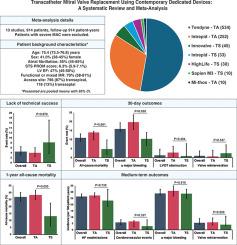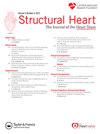Transcatheter Mitral Valve Replacement Using Contemporary Dedicated Devices: A Systematic Review and Meta-Analysis
IF 2.8
Q3 CARDIAC & CARDIOVASCULAR SYSTEMS
引用次数: 0
Abstract
Background
Dedicated transcatheter mitral valve replacement (TMVR) devices have emerged as a promising strategy for treating mitral regurgitation (MR) in high-risk patients with complex native valve anatomy. Early experience spans multiple devices utilizing both transapical and transseptal access. The aim of this study was to evaluate procedural, 30-day, and midterm outcomes of TMVR with contemporary dedicated mitral devices in patients with native MR.
Methods
A systematic search of Medline, Embase, and Cochrane Library (January 2010-January 2025) was conducted. Pooled outcome estimates were derived using random-effects models, excluding legacy devices and cases of mitral stenosis.
Results
Thirteen studies (914 patients) were included in the analysis. The mean age was 75.4 years, and 69.8% had functional or mixed MR. Technical success was 96.3%. Residual MR was mild or less in 99% of patients at 30 days and 98% at 1 year. All-cause mortality was 11.0% at 30 days and 26.4% at 1 year. Over a mean follow-up of 12.1 months, rates of heart failure (HF) hospitalizations, cerebrovascular events, and valve reinterventions were 26.2, 5.6, and 6.0 events per 100 patient-years, respectively. Compared with transseptal access, transapical showed higher 30-day major bleeding (19.2% vs. 10.4%, p = 0.03) and all-cause mortality at 30 days (14.0% vs. 4.7%, p <0.001) and 1 year (27.7% vs. 13.1%, p = 0.005). Midterm rates of HF readmissions, major bleeding, and valve reinterventions were comparable between access routes.
Conclusions
Contemporary dedicated TMVR devices demonstrate high technical success and sustained MR reduction. Transseptal access is associated with lower morbidity and mortality. Further research is needed to improve longer-term mortality and HF hospitalizations following TMVR with dedicated mitral devices.

经导管二尖瓣置换术使用现代专用装置:系统回顾和荟萃分析
背景:专用经导管二尖瓣置换术(TMVR)装置已成为治疗先天性瓣膜解剖复杂的高危患者二尖瓣返流(MR)的一种有前景的策略。早期的经验跨越多个设备,利用经根尖和经隔膜接入。本研究的目的是评估采用现代专用二尖瓣装置TMVR治疗先天性mr患者的手术、30天和中期结果。方法系统检索Medline、Embase和Cochrane图书馆(2010年1月- 2025年1月)。使用随机效应模型得出汇总结果估计,排除遗留装置和二尖瓣狭窄病例。结果13项研究(914例患者)纳入分析。平均年龄75.4岁,69.8%有功能性或混合性mr,技术成功率为96.3%。99%的患者在30天和98%的患者在1年的剩余MR轻度或更少。30天全因死亡率11.0%,1年全因死亡率26.4%。在平均12.1个月的随访中,心力衰竭(HF)住院率、脑血管事件率和瓣膜再干预率分别为每100患者年26.2、5.6和6.0次。与经间隔入路相比,经根尖入路30天大出血(19.2%比10.4%,p = 0.03)和30天(14.0%比4.7%,p <0.001)和1年(27.7%比13.1%,p = 0.005)的全因死亡率更高。中期心衰再入院率、大出血率和瓣膜再介入率在两种通路之间具有可比性。结论:当代专用TMVR装置具有很高的技术成功率和持续的MR降低。经隔膜入路与较低的发病率和死亡率有关。需要进一步的研究来改善使用专用二尖瓣装置TMVR后的长期死亡率和HF住院率。
本文章由计算机程序翻译,如有差异,请以英文原文为准。
求助全文
约1分钟内获得全文
求助全文
来源期刊

Structural Heart
Medicine-Cardiology and Cardiovascular Medicine
CiteScore
1.60
自引率
0.00%
发文量
81
 求助内容:
求助内容: 应助结果提醒方式:
应助结果提醒方式:


